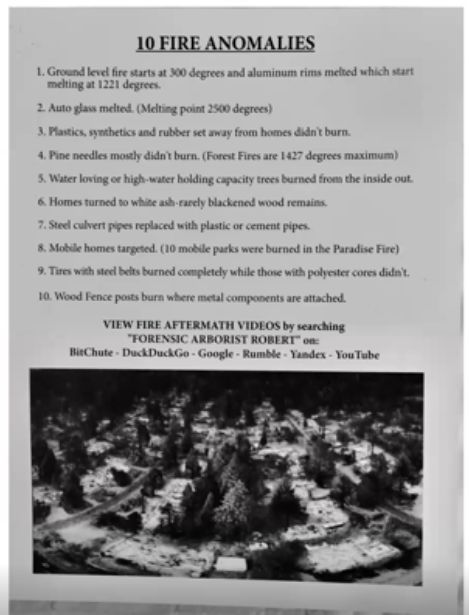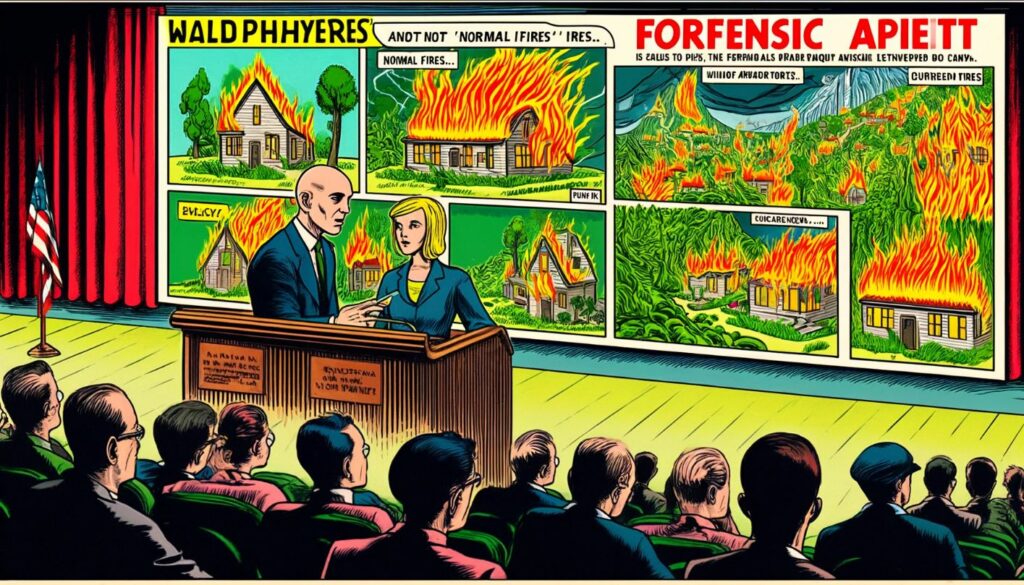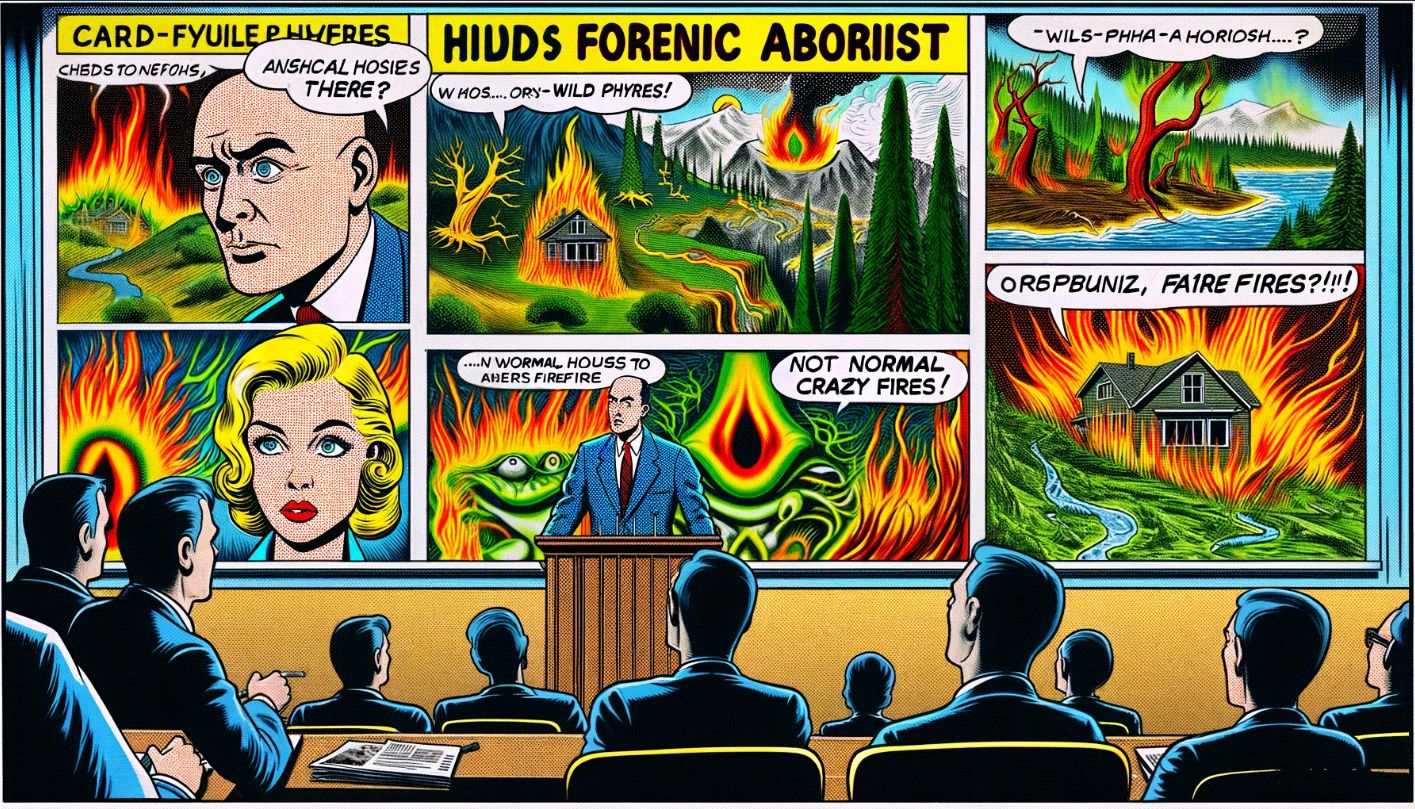DEW CLUES from Forensic Arborist Robert Brame
10 Fire Anomalies
- Ground level fire starts at 300 degrees (F) and aluminum rims melted which start melting at 1200 degrees F.
- Auto glass melted (Melting point 2,500 degrees F)
- Plastics, synethics and rubber set away from homes didn’t burn.
- Pine needles mostly didn’t burn. (Forest Fires are 1400 degrees maximum).
- Water loving or high-water holding capacity trees burned from the inside-out.
- Homes turned to white ash – rarely blackened remains.
- Steel culvert pipes replaced with plastic or cement pipes.
- Movile homes targeted (possibly because usually mostly metal construction?)
- Tires with steel belts completely burned while those with polyester cores didn’t.
- Wood fence posts burn where metal components are attached.
Excellent interview w/ Robert Brame by Peggy Hall — https://www.youtube.com/watch?v=rtOKf4rbKnY


The New Normal: Forensic Arborist Robert Brame’s Revelations on Wildfires and Directed Energy Weapons
In the rapidly evolving landscape of global environmental phenomena, forensic arborist Robert Brame’s findings offer a startling perspective on what he terms the “new normal” in wildfire behavior. Brame’s meticulous investigations reveal a pattern that starkly contrasts with traditional forest fire dynamics. In these new wildfires, only houses and vehicles are reduced to white ash, akin to cremation, while the surrounding trees, grass, and shrubs remain largely unscathed. This phenomenon, Brame suggests, points to the use of microwave-directed energy weapons (DEWs).
Traditional vs. New Normal Wildfires
In a conventional forest fire, the flames typically consume all available fuel—trees, grass, and shrubs—before partially burning structures, leaving behind blackened remains, soot, and partially charred items. The fuel in a typical forest fire is insufficient to completely cremate a house; the intense heat (and fuel) required for complete combustion (and cremation down into white powdery ash) is rarely present.
In stark contrast, the new normal wildfires described by Brame demonstrate an almost surgical precision in destruction. Houses and vehicles burn intensely, down to a fine white ash, while the vegetation around them is often untouched. This selective incineration points to the involvement of advanced technology—specifically, microwave DEWs that can superheat targeted materials, causing steel structures to insta-rust and combusting homes with an intensity that normal forest fires cannot achieve.
Microwave Directed Energy Weapons and Their Effects
Microwave DEWs operate by inducing eddy currents in conductive materials, causing rapid heating and, ultimately, combustion. The superheating effect on steel structures leads to instant rusting and weakening, further contributing to the collapse and complete combustion of the targeted buildings. These weapons are designed to deliver precise, high-energy bursts, which can explain the observed selective burning.
Strategic Implications: 15-Minute Smart Cities and Agenda 21
Brame’s findings suggest a sinister strategic motive behind these targeted burnings. The concept of “15-minute smart cities,” where residents can access all necessary services within a short walk or bike ride, aligns with broader goals outlined in the United Nations’ Agenda 21 and Agenda 2030. These agendas advocate for “sustainable” urban development, which, while seemingly benign, could be interpreted as a push to concentrate populations in controlled urban areas. One extreme danger often unnoticed by most persons is the ability for closely-gathered groups to be sprayed with chemicals and easily exposed to toxins including electromagnetic irradiation by microwaves and other means.
By driving people off remote lands and into cities, authorities can exert greater control over populations. Urban residents can be more easily monitored, forced to comply with public health directives, and subjected to controlled food supplies, potentially leading to malnutrition and dependence. This urban migration undermines individuals’ ability to live independently and make autonomous choices.
The Vatican Jesuits and Raytheon’s Role
Central to this understanding is the influence of the Vatican Jesuits, a religious order historically committed to countering Protestantism, which played a significant role in shaping America. Brame asserts that the Jesuits control Raytheon, a leading manufacturer of DEW weapons. The Jesuit motto, “go forth and set the world on fire,” attributed to Pierre Teilhard de Chardin, takes on a literal and menacing interpretation in this context.
The use of DEWs to target Protestant-majority regions in America can be seen as an extension of the Jesuits’ historical mission to bring territories under the control of the Vatican. This perspective underscores the longstanding entanglement of military force and religious influence throughout history.
Military and Religion: A Historical Symbiosis
The symbiotic relationship between military power and religious institutions has been a constant throughout history. From the Crusades to the modern era, religious motivations have often underpinned military campaigns. Brame’s findings do not contraindicate this dynamic continues today, with advanced military technologies being wielded in service of broader ideological and strategic goals.
Conclusion
Robert Brame’s findings on the “new normal” in wildphyre behavior and the apparent use of microwave DEWs offer a profound and disturbing insight into contemporary environmental and geopolitical strategies. By examining these patterns through the lens of historical military-religious alliances and modern strategic objectives, Brame’s work challenges us to reconsider the forces shaping our world today. Whether one views these developments as a necessary adaptation to global challenges or a covert strategy for control, the implications are profound and far-reaching.

Forensic Arborist Robert speaking. 120 trips now to 42 forest fire aftermath. Mostly in California possibly three were natural fires the rest, directed energy weapons